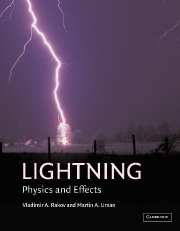Book contents
- Frontmatter
- Contents
- Preface
- 1 Introduction
- 2 Incidence of lightning
- 3 Electrical structure of lightning-producing clouds
- 4 Downward negative lightning discharges to ground
- 5 Positive and bipolar lightning discharges to ground
- 6 Upward lightning initiated by ground-based objects
- 7 Artificial initiation (triggering) of lightning by ground-based activity
- 8 Winter lightning in Japan
- 9 Cloud discharges
- 10 Lightning and airborne vehicles
- 11 Thunder
- 12 Modeling of lightning processes
- 13 The distant lightning electromagnetic environment: atmospherics, Schumann resonances, and whistlers
- 14 Lightning effects in the middle and upper atmosphere
- 15 Lightning effects on the chemistry of the atmosphere
- 16 Extraterrestrial lightning
- 17 Lightning locating systems
- 18 Deleterious effects of lightning and protective techniques
- 19 Lightning hazards to humans and animals
- 20 Ball lightning, bead lightning, and other unusual discharges
- Appendix: Books on lightning and related subjects
- Index
9 - Cloud discharges
Published online by Cambridge University Press: 05 June 2013
- Frontmatter
- Contents
- Preface
- 1 Introduction
- 2 Incidence of lightning
- 3 Electrical structure of lightning-producing clouds
- 4 Downward negative lightning discharges to ground
- 5 Positive and bipolar lightning discharges to ground
- 6 Upward lightning initiated by ground-based objects
- 7 Artificial initiation (triggering) of lightning by ground-based activity
- 8 Winter lightning in Japan
- 9 Cloud discharges
- 10 Lightning and airborne vehicles
- 11 Thunder
- 12 Modeling of lightning processes
- 13 The distant lightning electromagnetic environment: atmospherics, Schumann resonances, and whistlers
- 14 Lightning effects in the middle and upper atmosphere
- 15 Lightning effects on the chemistry of the atmosphere
- 16 Extraterrestrial lightning
- 17 Lightning locating systems
- 18 Deleterious effects of lightning and protective techniques
- 19 Lightning hazards to humans and animals
- 20 Ball lightning, bead lightning, and other unusual discharges
- Appendix: Books on lightning and related subjects
- Index
Summary
One flash produced five short radial streamers; in another flash, pulse sources were distributed almost randomly, like raisins in fruit cake …. Two flashes produced streamers that appeared to encircle their origins several times …. Only two flashes produced only one stepped leader channel each; 19 extended along multiple paths.
D.E. Proctor (1997)Introduction
The term cloud discharges is used to denote three types of lightning: (i) intracloud discharges, those occurring within the confines of a thundercloud, (ii) intercloud discharges, those occurring between thunderclouds, and (iii) air discharges, those occurring between a thundercloud and clear air. It is thought that the majority of cloud discharges are of the intracloud type, although no reliable statistical data are found in the literature to confirm that this is the case. Often the abbreviation IC (for intracloud flash) is used to refer to all cloud flashes. Ogawa and Brook (1964) reported that intracloud and cloud-to-air lightning discharges produced similar overall electric field changes. As discussed in Section 2.7, approximately three-quarters of lightning discharges do not contact ground, although this fraction depends on storm type, the stage of storm development, and possibly other factors. The early stages of thunderstorm development tend to be dominated by cloud discharges. According to Williams et al. (1989), 10 or more cloud flashes may occur before the first cloud-to-ground flash.
- Type
- Chapter
- Information
- LightningPhysics and Effects, pp. 321 - 345Publisher: Cambridge University PressPrint publication year: 2003
- 5
- Cited by



